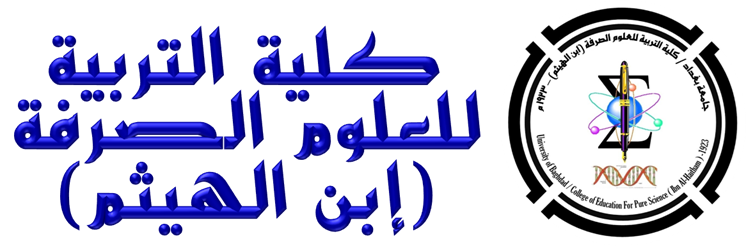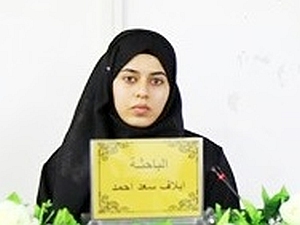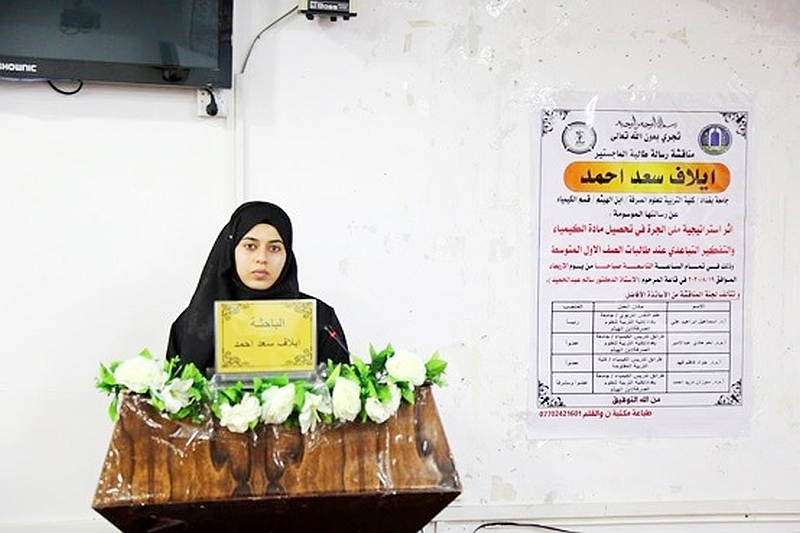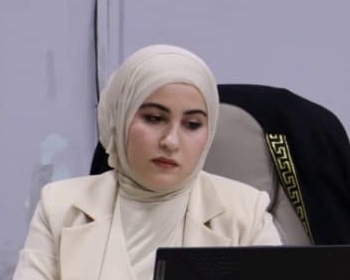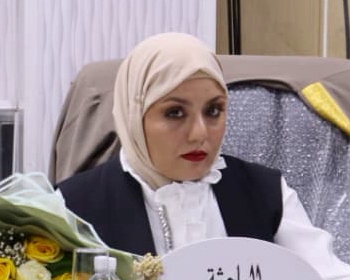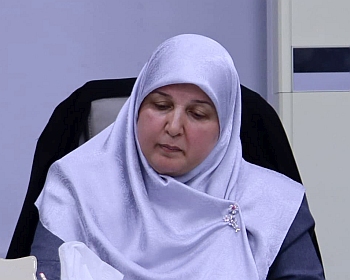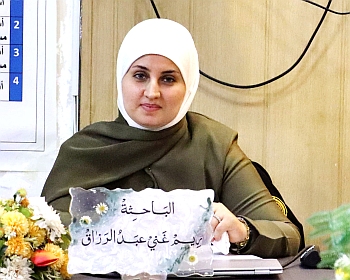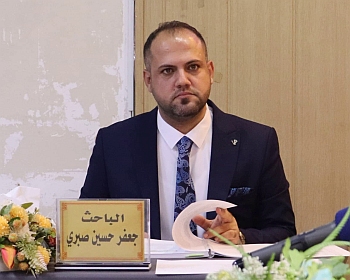ناقش قسم الكيمياء في كلية التربية للعلوم الصرفة ( ابن الهيثم ) رسالة الماجستير الموسومة ( أثر استراتيجية ملئ الجرة في تحصيل مادة الكيمياء والتفكير التباعدي عند طالبات الصف الأول المتوسط ) ، في تخصص طرائق تدريس علوم الكيمياء ، للطالبة ( إيلاف سعد أحمد ) التي انجزتها تحت اشراف التدريسية في القسم ( أ.م.د. سوزان دريد أحمد ) ونوقشت من قبل لجنة المناقشة التي تالفت من الاعضاء المدرجة اسمائهم فيما يأتي :-
-
أ.د. اسماعيل ابراهيم علي . (رئيسا)
-
أ.م.د. نغم هادي عبد الامير . (عضوا)
-
أ.م.د. جواد كاظم فهد. (عضوا)
-
أ.م.د سوزان دريد احمد (عضوا ومشرفا)
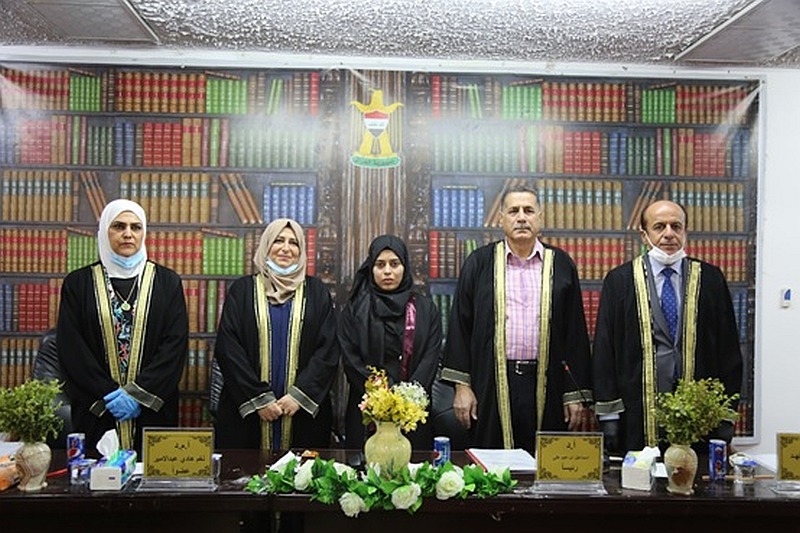 ويهدف البحث الحالي الى التعــرف على (أثر استراتيجية ملئ الجرة في تحصيل مادة الكيمياء والتفكير التباعدي عند طالبات الصف الأول المتوسط ).
ويهدف البحث الحالي الى التعــرف على (أثر استراتيجية ملئ الجرة في تحصيل مادة الكيمياء والتفكير التباعدي عند طالبات الصف الأول المتوسط ).
ولتحقيق ذلك اعتمدت الباحثة التصميم التجريبي ذا الضبط الجزئي, كما تحدد مجتمع البحث بطالبات الصف الأول المتوسط في جـميع المدارس الثانوية والمتوسطة والاساسية الحكومية النهارية لقاطع المأمون في المديرية العامة لتربية محافظة بغداد / الكرخ الثانية للعام الدراسي (2019-2020), واختيرت متوسطة غزة للبنات بالتعيين القصدي ليكن طالبات عينة البحث , ثم اختيرت شعبتان من الصف الاول المتوسط بصورة عشوائية لتمثل احداهما المجموعة التجريبية والاخرى المجموعة الضابطة ,وبلغت عينة البحث (65) طالبة بواقع (31) طالبة في المجموعة التجريبية شعبة (ب) التي درست على وفق استراتيجية ملئ الجرة , و(34) طالبة في المجموعة الضابطة شعبة (ج) التي درست وفقاً للطريقة الاعتيادية , تمت مكافئة مجموعتي البحث في المتغيرات التالية (العمر الزمني بالأشهر, واختبار الذكاء, و درجات اختبار المعلومات السابقة في مادة العلوم, و درجات التحصيل الدراسي السابق لمادة العلوم للصف السادس الابتدائي, واختبار التفكير التباعدي), كما حددت المادة العلمية بالفصول الاربعة الاولى من كتاب العلوم (الكيمياء) للصف الاول المتوسط المقرر تدريسه للعام الدراسي(2019- 2020م).
وصيغت الاغراض السلوكية لهذه الفصول التي بلغ عددها (305) اغراض سلوكية بحسب تصنيف بلوم للأهداف (تذكر, واستيعاب, وتطبيق , وتحليل, وتركيب) وفقاً لعدد الحصص المقترحة لكل فصل , ثم اعدت الخطط التدريسية لمجموعتي البحث , وكان عددها(34) خطة لكل مجموعة,واستمرت التجربة التي ابتدأت في يوم الاحد الموافق (2019/10/13) وانتهت يوم الخميس الموافق (2020/1/23) .
وتم اعداد أداتين للبحث, وهما الاختبار التحصيلي ,واختبار التفكير التباعدي, اذ تألف الاختبار التحصيلي من(40) فقرة اختبارية من نوعين, أحدهما يتمثل بالاختبارات الموضوعية من نوع الاختيار من متعدد بأربعة بدائل بلغ عددها (38) فقرة تقيس المستويات (التذكر, والاستيعاب, والتطبيق) , وفقرتين من النوع المقالي تقيس مستوى(التحليل) وتمثلت بالفقرتين (40,39) , والاخر اختبار التفكير التباعدي , الذي تألف من (9) فقرات , وتم التحقق من صدق الاداتين بعد عرضهما على مجموعة من المحكمين, وقد جرى تطبيقهما على عينتين استطلاعيتين احداهما لمعرفة مدى وضوح الفقرات وزمن الاجابة والاخرى لغرض تحليل فقرات الاختبار احصائيأً وحساب الخصائص السايكومترية لهما، اذ تم تحليل البيانات ومعالجتها احصائياً باعتماد الحقيبة الاحصائية SPSS. واشتملت المعادلات الاتية( معادلة الانحراف المعياري, ومعادلة t-test , ومعادلة ألفا- كرونباخ, ومعامل ارتباط بيرسون ,ومعامل الصعوبة, ومعامل التمييز لفقرات الاختبار , وفعالية البدائل للفقرات الموضوعية, ومعادلة كوبر, ومعادلة حجم الاثر),وقد توصلت الباحثة إلى :
-
وجود فرق ذي دلالة إحصائية عند مستوى دلالة (05) بين متوسط درجات تحصيل طالبات المجموعة التجريبية اللاتي درسن مادة العلوم(الكيمياء) على وفق استراتيجية ملئ الجرة , ومتوسط درجات طالبات المجموعة الضابطة اللاتي درسن مادة العلوم (الكيمياء) على وفق الطريقة الاعتيادية في اختبار التحصيل لمادة الكيمياء لصالح المجموعة التجريبية.
-
وجود فرق ذي دلالة إحصائية عند مستوى دلالة (05) بين متوسط درجات طالبات المجموعة التجريبية اللاتي درسن مادة العلوم(الكيمياء) على وفق استراتيجية ملئ الجرة , ومتوسط درجات طالبات المجموعة الضابطة اللاتي درسن مادة العلوم (الكيمياء) على وفق الطريقة الاعتيادية في اختبار التفكير التباعدي لصالح المجموعة التجريبية.
وفي ضوء ذلك خرجت الباحثة بعدد من النتائج والاستنتاجات وقدمت عددآ من التوصيات والمقترحات الاتية :
-
الاهتمام من قبل مدرسين ومدرسات الكيمياء في الخطط الدراسية اليومية لتدريس طلبة الصف الاول المتوسط وفقاً لاستراتيجية ملئ الجرة لاثرها في رفع مستوى تحصيل الطالبات .
-
تنظيم دورات تدريبية لمدرسي ومدرسات الكيمياء في اثناء الخدمة لتدريبهم على توظيف خطوات استراتيجية ملئ الجرة في المواقف التعليمية.
-
ان تكون مفردات مادة طرائق التدريس في كليات التربية متضمنة استراتيجية ملئ الجرة كي يلم بها مدرسو ومدرسات المستقبل.
-
توظيف استراتيجية ملئ الجرة كأنموذج في التدريس في التعليم الابتدائي والثانوي.
-
اعتماد اختبار التفكير التباعدي كأداة للكشف عنهُ لدى طلبة المرحلة المتوسطة وتوجيه انظار المدرسين والمدرسات نحو توظيفه .
-
الاهتمام بالتفكير التباعدي كمبدأ في التدريس لما له من اهمية في حل كثير من المشكلات والقضايا التي تواجه الطلبة.
-
الاهتمام بالتفكير التباعدي عن طريق توفير فرص مثيرة للتفكير؛ لأنه يسهم في تنشيط ذهن الطلبة ويحفز على ايجاد التفسيرات واختيار الحلول المناسبة للمشكلات .
The effect of the Jar filling strategy on the achievement
of chemistry and divergent thinking among
First Intermediate students
By Elaf.S.Ahmed
Supervised by Asst.prof.Dr.Susan .D.Ahmed
Abstract
The aim of the research is to identify the impact of the jar filling strategy on the achievement of chemistry and divergent thinking among middle school students
To achieve the goal of the research, the researcher adopted the experimental design with partial control, as the research community determined the middle first class students in all secondary and intermediate schools and basic government schools in the morning of the safe section in the General Directorate of Education in Baghdad / Karkh second governorate for the academic year (2019-2020). The intention was that the students of the research sample be chosen, then two middle-class divisions were randomly chosen to represent one experimental group and the other a control group, and the research sample reached (65) students by (31) students in the experimental group division (B) that was studied according to the jar-filling strategy, and (34) A student in the control group, Division (C), who studied according to the usual method, and the researcher rewarded the two research groups in the following variables (chronological age in months, intelligence test, test scores for previous information in the science subject, degrees of previous academic achievement in science for the sixth grade of primary school, Divergent thinking test), and the scientific subject was identified in the first four chapters of the science book (chemistry) for the first intermediate grade, to be taught for the academic year (2019-2020 AD
The behavioral purposes of these chapters, which numbered (305), were formulated as a behavioral purpose according to Bloom’s classification of goals (remember, assimilate, apply, analyze, synthesize) according to the number of classes proposed for each chapter. Then, the teaching plans for the two research groups (34) were prepared for each group, And the experiment that started on Sunday (13/10/2019) and ended on Thursday (23/1/2020) continued
Two tools were prepared for the research, which is the achievement test and the divergent thinking test, as the achievement test consisted of (40) test items of two types, one of which is the objective tests of the multiple choice type with four alternatives that reached (38) paragraphs measuring levels (remembering, understanding, and applying ), And two paragraphs of the frying type measure the level of (analysis) and were represented by two paragraphs (40,39). As for the divergent thinking test, it consisted of (9) paragraphs, and the validity of the two tools was checked after presenting them to a group of arbitrators. They were applied to two survey samples, one to find out the clarity of the paragraphs and the response time and the other for the purpose of analyzing the test items statistically and calculating their psychometric properties, as the data were analyzed and statistically processed using the SPSS statistical bag. The following equations included (the standard deviation equation, the t-test equation, the Alpha-Cronbach equation, the Pearson correlation coefficient, the difficulty coefficient, the coefficient of discrimination for the test items, the effectiveness of the alternatives to the objective paragraphs, the Cooper equation, and the effect size equation), and the researcher concluded:
There is a statistically significant difference at a level of significance (0.05) between the average achievement scores of the experimental group students who studied the science (chemistry) subject according to the jar filling strategy, and the average grades of the control group students who studied the science (chemistry) subject according to the usual method in An achievement test for chemistry for the benefit of the experimental group
– There is a statistically significant difference at the level of significance (0.05) between the average scores of students of the experimental group who studied science (chemistry) according to the jar filling strategy, and the average scores of students of the control group who studied the subject of science (chemistry) according to the usual method of testing Divergent thinking in favor of the experimental group
In light of this, the researcher came up with a number of results and conclusions and made a number of recommendations and proposals
Research objectives
The current research aims to identify the effect of the jar filling strategy on
Academic achievement of female students of the first intermediate grade in the subject of chemistry
. – Divergent thinking for first-grade intermediate students
Recommendations
In light of the results of the research, the researcher came up with the following recommendations
– Attention by chemistry teachers and teachers in the daily study plans for teaching first-grade intermediate students according to the jar-filling strategy for its effect on raising the level of students’ achievement
– Organizing in-service training courses for chemistry teachers and teachers to train them to employ strategic steps to fill the jar in educational situations
– That the vocabulary of teaching methods in the Faculties of Education include the strategy of filling the jar so that future male and female teachers know it
– Using the strategy of filling the jar as a model in teaching in primary and secondary education
– Adopting the divergent thinking test as a tool to detect it among middle school students and direct the attention of male and female teachers towards employing it
– Paying attention to divergent thinking as a principle in teaching because of its importance in solving many problems and issues facing students
– Paying attention to divergent thinking by providing exciting opportunities for thinking. Because it contributes to revitalizing students’ minds and stimulates finding explanations and choosing appropriate solutions to problems
